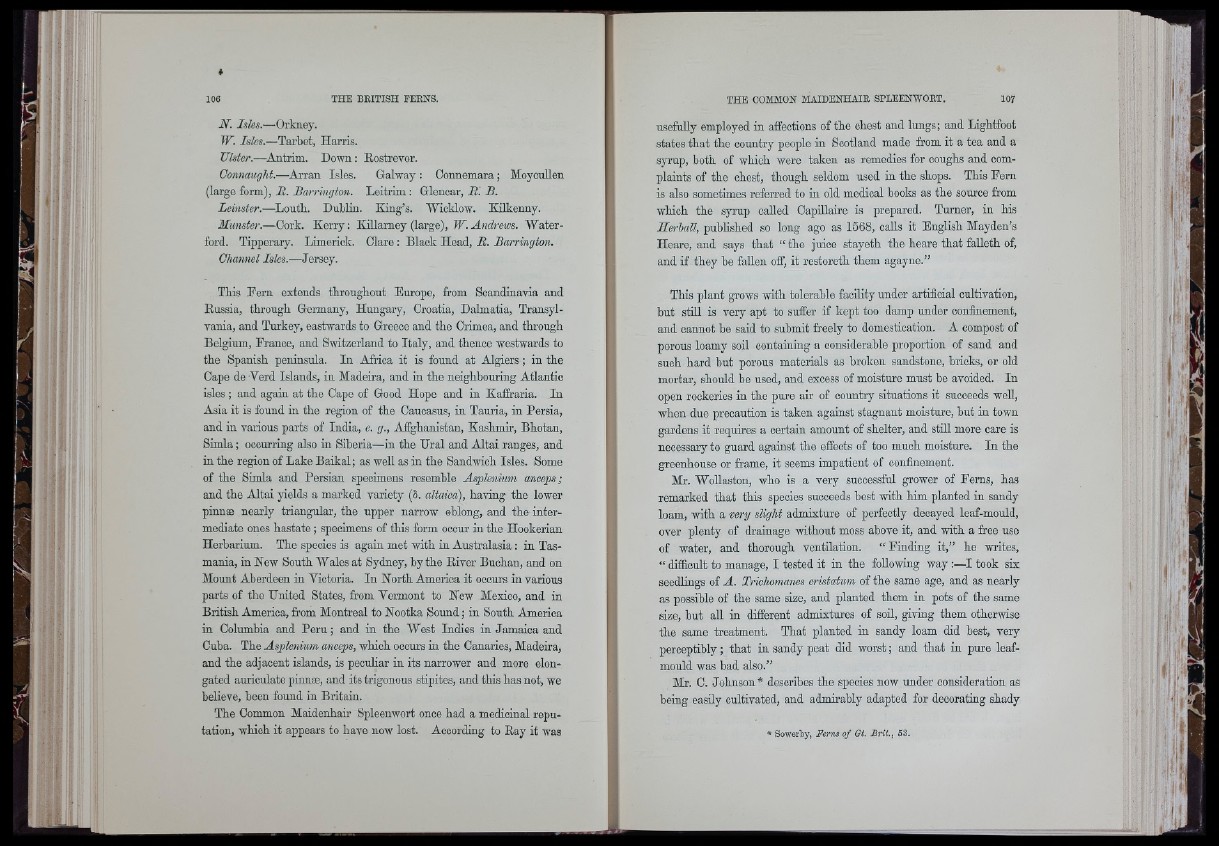
iii
106
N. Isles.—Orkney.
W. Isles.—Tarbet, Harris.
Ulster.—Antrim. Down : Eostrevor.
Connaught.-—^Arran Isles. Galway : Connemara ; Moycnllen
(largo form), R. Barrington. Leitrim ; Glenoar, R'. B.
Leinster.—Lontli. Dublin. King’s. Wicklow. Kilkenny.
Munster.—Cork. Kerry: Killarney (large), W. Andrews. Waterford.
Tipperary. Limerick. Clare : Black Head, R. Barrington.
Channel Isles.—Jersey.
Tbis Fern extends througbout Europe, from Scandinavia and
Eussia, through Germany, Hungary, Croatia, Dalmatia, Transylvania,
and Turkey, eastwards to Greece and the Crimea, and through
Belgium, France, and Switzerland to Italy, and thenoe westwards to
the Spanish peninsula. In Africa it is found at Algiers ; in the
Cape de Verd Islands, in Madeira, and in the neighbouring Atlantic
isles ; and again at the Capo of Good Hope and in Kaffraria. In
Asia it is found in the region of the Caucasus, in Tauria, in Persia,
and in various parts of India, e. g., Affghanistan, Kashmii-, Bhotan,
Simla ; occurring also in Siberia—in the Ural and Altai ranges, and
in the region of Lake Baikal; as well as in the Sandwich Isles. Some
of the Simla and Persian specimens resemble Asplenium anceps;
and the Altai yields a marked variety (S. altaica), having the lower
pinnæ nearly triangular, the upper narrow ohlong, and the intermediate
ones hastate ; specimens of this form oooui' in the Hookerian
Herbarium. The species is again met with in Australasia : iu Tasmania,
in New South Wales at Sydney, by the River Buchan, and on
Mount Aberdeen in Victoria. In North America it occurs in various
parts of tho United States, from Vermont to New Mexico, and in
British America, from Montreal to Nootka Sound ; in South America
in Columbia and Peru ; and in the West Indies in Jamaica and
Cuba. The Asplenium anceps, which occurs in the Canaries, Madeira,
and the adjacent islands, is peculiar in its narrower and more elongated
auriculate pinnæ, and its trigonous stipites, and this has not, we
believe, been found in Britain.
The Common Maidenhair Spleenwort once had a medicinal reputation,
which it appears to have now lost. According to Ray it was
u s e f u l l y employed in affections of the chest and lungs; and Lightfoot
states that the country people in Scotland made from it a tea and a
syrup, both of which wore taken as remedies for coughs and complaints
of the chest, though seldom used in the shops. This Fern
is also sometimes referred to in old medical books as the source from
which the syrup called Capillaire is prepared. Turner, in his
Herhall, published so long ago as 1668, calls it English Mayden’s
Heare, and says that “ tho juice stayeth the heare that faUeth of,
and if they be faUen off, it restoreth them agayne.”
This plant grows with tolerable facility under artificial cultivation,
but still is very apt to suffer if kept too damp under confinement,
and cannot be said to submit freely to domestication. A compost of
porous loamy soil containing a considerable proportion of sand and
such hard but porous materials as broken sandstone, bricks, or old
mortar, should be used, and excess of moisture must be avoided. In
open rookeries in the pure air of country situations it succeeds well,
when due precaution is taken against stagnant moisture, but in town
gardens it requires a certain amount of shelter, and stiU more care is
necessary to guard against the effects of too much moisture. In the
greenhouse or frame, it seems impatient of confinement.
Mr. WoUaston, who is a very successful grower of Ferns, has
remarked that this species succeeds best with him planted in sandy
loam, with a very slight admixture of perfectly decayed leaf-mould,
over plenty of drainage without moss above it, and with a free use
of water, and thorough ventUation. “ Finding it,” he writes,
“ difficult to manage, I tested it in tho foUowing way :—I took six
seedlings of A. Trichomanes cristatum of the same age, and as nearly
as possible of the same size, and planted them in pots of the same
size, but all in different admixtures of soil, giving them otherwise
the same treatment. That planted in sandy loam did best, very
perceptibly; that in sandy peat did worst; and that in pure leaf-
mould was bad also.”
Mr. 0. Johnson* describes the species now under consideration as
being easUy cxUtivated, and admirably adapted for decorating shady
* Sowerby, Ferns o f Gt. B r it., 53.
' M
Si 'V
ilr fci '
■ i
ft